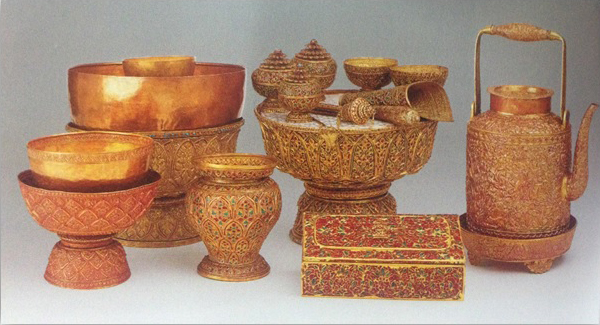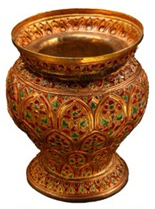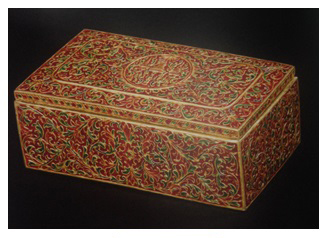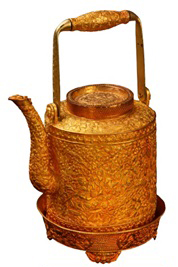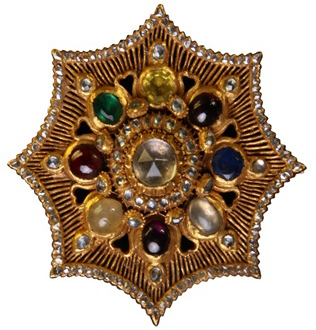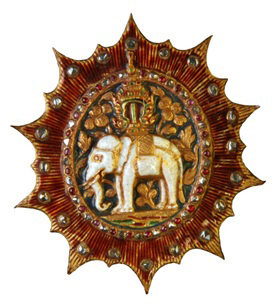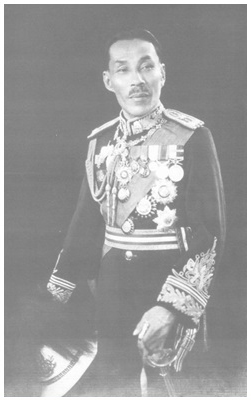Since when Sukhothai was the capital, Thai kings held the supreme power over the royal kingdom. They ruled the country to preserve the wellness of the people according to ten kingly virtues. However, the administration of the country was entrusted to royal family members and noblemen who acted on the king’s behalf, thus relieved the kings’ off their burden. Those who did service to the country would receive a status in terms of land, a title, a title named by the king, and an office, to indicate their power and prestige. The king would bestow to them regalia to express their social status, and to award them for their good service. These regalia must be returned when a higher rank is obtained, or when the officer has died or left the office.
Regalia refer to a decoration or an accessory to express the prestige and importance of a public office. It is bestowed by the king to a royal family member in celebration of a higher rank, and to ministers, high-ranked officials, or noblemen who have rendered good service to the country as a reward. The materials used to make regalia vary according to the title and the rank of the receiver. The designs on the regalia also vary in each period. The bestowment of regalia has been an important custom of the court.
The use of regalia in Thai court first appeared on the fifth stone inscription found at Wat Pa Mamuang Temple, which was assumed to have been produced during the reign of King Maha Thamma Racha I or King Lithai of Sukhothai. There was a mention of the king’s regalia including a crown, a sword, and a multi-tiered umbrella. However, there was no mention of a bestowment of regalia to a royal family member or a civil servant.
Later in the Ayutthaya period, the royal law and the national archives of Ayutthaya mentioned, in several places, bestowment of regalia to both male and female court officers, and those who had rendered good service in public administration and at war. According to said evidence, regalia in this period can be divided in the following categories:
- Utensils include a footed tray, a tray with a pedestal, a water ewer or gourd-shaped water container, a tray for betel set, a tray for drinks, a golden betel utensil, a golden bowl, a golden case, a mat made from silver or gold thread, a cushion made or covered with animal fur.
- High insignia include a multi-tiered umbrella, a long-handled double-tiered umbrella, an oil-paper umbrella, a tapered-top umbrella, a long-handled shade, a long-handled umbrella, a golden shade with a floor stand.
- Royal vehicles include a gold and copper alloy palanquin, a palanquin with a dragon decoration, a litter with ivory decoration, a litter with decorative petals, a sedan chair, a tripartite royal boat.
- Weapons include a sword with a golden shaft, a double-edged sword, a sword with a gold sheath, a sword with a single-headed naga decoration.
- Clothing includes a long gown, cloth made with gold and silk thread, cloth with gold embroidery decoration, white cloth with decorative drawings on the brim, silk cloth with checkered design, golden shoes, velvet shoes.
- Headwear includes a headpiece, a tapered-top high hat, a hat for royal travel.
During the Thonburi period, there was evidence of bestowment of regalia to the noblemans who held an important offices and those who had rendered good service in public administration and at war. According to documents from the Thonburi period, there were newly-added regalia as the following:
- Utensils include a tray with a complete betel set, a spittoon.
- Headwear includes a gold headwear with a plume, a hat with a golden top.
- Clothing includes a travel shirt, a shirt made with gold and silk thread, a sleeping gown, traditional trousers, shoes with an embroidered striped gold pattern, a Japanese styled shirt.
- Weapons include a Japanese style sword, a javelin, a gun with a shaft inlaid with gold, a sword, a rifle, a musket, a lance with a red tuft decoration, a spike with a decoration, a knife with a shaft made of gold-plated silver shaft, a gun for elephant warfare, a spear, and a spike.
- Auspicious charms include gold rosary, a ring made with nine gems.
Later when King Yodfa Chulaloke or King Rama I founded Krung Rattanakosin as the capital city, the king gave an order that Phraya Petch Pichai who had served since the Ayutthaya period explained the customs and the tradition of Ayutthaya court. Therefore, the tradition of awarding regalia in the Rattanakosin period which has continued until today is a direct heritage from the Ayutthaya and the Thonburi period. Regalia in the Rattanakosin period can be categorised as the following:
- Utensils include a tray with a complete betel set, a teapot and cups, a water bowl and a cup, a wash bowl, and betel box.
- Headwear includes a golden multi-tiered crown, a high hat, a hat with brocade decoration.
- Clothing includes a long girdle, an official gown.
- Weapons include a sword inlaid with gold, a sword with a shaft made in the shape of three-headed naga.
- Auspicious charms include a gold plumb line, a breast chain decorated with gemstones, a metal amulet.
- High insignia include a white seven-tiered umbrella, a white five-tiered umbrella, three-tiered umbrella, a white multi-tiered umbrella with gold decoration on the brim, a multi-tiered umbrella made with linen cloth, golden and silver threads, a multi-tiered umbrella for use at a royal funeral, a high insignia decorated with gold, golden high insignia with metal decorations.
- Royal vehicles include small-sized and large-sized palanquins with multi-tiered and spired roof, a shaded litter.
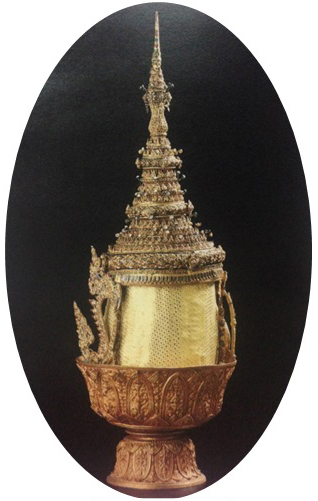
A golden multi-tiered crown
It was only during the reign of King Rama IV, in 1857 AD, when the king commissioned the first insignia to be made in the form of a badge as in western countries, called Dara Ayaraphot. This insignia is modeled after the royal emblem Ayaraphot. The king commissioned two pieces to be used on His personal royal garment, and another two pieces for King Pinklao.
Dara Ayaraphot
Later in 1858 AD, the king commissioned another model of an insignia, called Dara Nopparat. It was a badge made in a shape of an octagram, decorated with nine types of precious stone. The brim of the star is decorated with diamonds. The king commissioned one piece to be used on His royal garment, and another three pieces for other royal family members. Moreover, the king also intended to award this insignia to those who has been decorated with the ring of nine precious stones.
Dara Nopparat
In 1861 AD, the king commissioned the making of Dara Chang Pheuk. It was made from a gold plate embossed in the image of a white elephant which is the national symbol of Siam, and the royal crown which refers to the name of the king. King Chom Klao gave Dara Chang Pheuk to the heads of other countries, royal guests, royal family members, noblemans who had rendered great service to the country, those who were to serve in foreign lands, foreign nationals who served in Thai civil service, and foreign diplomats. On this occasion the king coined the word Dara, which had been translated from the word ‘star’ in English, to refer to an insignia that is to be worn on the chest.
Dara Chang Pheuk
During the reign of King Chulachomklao, the king ordered that there be an improvement to the royal decorations. New seals, Dara and shoulder-straps were added. New ranks were named. The king passed a bill that designates different orders of royal decorations. However, the tradition continued as before; the king awarded regalia to princes and princesses at royal tonsure ceremonies, and when a royal family member was endowed with a new department and a higher rank. Furthermore, in 1873 the king installed a new type of a royal decoration, Chulachomklao Decoration, and commissioned some decorative accessories dedicated to it. Therefore, it can be said that items of royal insignia were also given to those who had been awarded Chulachomklao Decoration.
Crown Prince Maha Vajirunhis at royal tonsure ceremony
His Royal Highness Prince Oskar Nutid
Later, since the numbers of noblemans have greatly increased, the bestowment of regalia were no longer as fast nor convenient. Thus, King Chulachomklao discontinued the practice, and awarded only royal decorations to civil servants. However, the tradition was preserved for members of the royal family. Regalia were awarded when His Royal Highness Prince Oskar Nutid was promoted to Krom Muen Anuwat Chaturon in 1920, as well as when Mom Chao Apha Phunni Sawat was promoted to Phra Chao Worawong Ther Phra Ong Chao Apha Phunni in 1929.

Nowadays, regalia are awarded on the occasion that a royal prince or princess is endowed with a new department or promoted to a higher rank. Examples of such occasions are the promotion of the Crown Prince Maha Vajiralongkorn and the Crown Princess Maha Chakri Sirindhorn, the celebration of the title of Her Royal Highness Princess Soamsawali, and the receivers of Chulachomklao Royal Decoration in the special first rank, the first rank, the special second rank, the second rank, and the special third rank. The purpose is to preserve the tradition that has continued since the ancient time. However, since the numbers of the receivers of Chulachomklao Royal Decoration increased greatly, the bestowment of regalia has been discontinued. However, the receivers of this order of decoration who would be qualified for the regalia of this rank can borrow the royal items from the Royal Ceremonial Division, the Bureau of the Royal Household.
The regalia of the Crown Princess Maha Chakri Sirindhorn
In the present, the regalia are kept and maintained by the Bureau of Grand National Treasure. Some selection are being exhibited at the Hall of Royal Regalia, Royal Decorations and Coins in the Royal Grand Palace. Current exhibitions are the regalia of the Crown Princess Maha Chakri Sirindhorn, and those of Her Royal Highness Princess Soamsawali, as well as other orders of regalia and insignia. The exhibitions open daily 8.30 - 16.00, with an exception of when a royal ceremony is held.
*A curator at Bureau of Grand National Treasury, the Treasury Department

